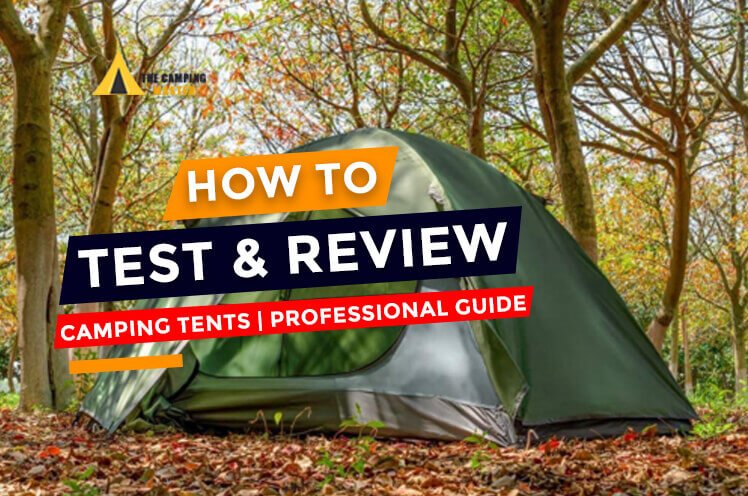Testing and reviewing camping tents takes a lot of time and effort. Still, it is vital to ensure that camping enthusiasts are well-informed and choose the right tent for their camping expeditions. This article will provide insight into my technique of how I test and review camping tents, and also, I am going to help you make the best decision about what tent you need to go camping. If you want to camp in style and comfort and have fun, you should invest in a tent that has been well-tested and reviewed only by reliable sources.
As you know, the tent manufacturers perform factory testing of the tents in artificial testing environments to check their product’s functionality and quality. However, based on the factory testing results, you cannot judge if the tent is a good fit for your camping style and, more importantly, if it has any limitations you need to be aware of.
So, my testing methodology involves testing the tent in a natural camping environment and under actual conditions to get the most accurate results. This way, you get a focused and unbiased product review from a hands-on user. This is why my thoughts are trusted and appreciated by many camping enthusiasts.

My Review Process of Testing Camping Tents
My testing methodology starts with online research about top-rated tents, reviewing their specifications, reading hundreds of user reviews, and analyzing their pros and cons. It is time-consuming, but it helps pin down the best tents among hundreds of choices available. Throughout the process, we hunt for products that can address a variety of users, taking into account crucial factors like weather protection, seasonality, ease of use, and budget-friendliness.
The next step is to purchase the selected tents and take them out for field tests under various camping conditions. The tents are set up in the open and evaluated based on some crucial factors, which I will discuss later in this article. An evaluation sheet is prepared for each tent that documents all the tent’s specifications and testing results. Ultimately, all the evaluation sheets are compared to assess commonalities, prominent features, quality, durability, and pros and cons for each tent.
By following these steps, I aim to provide an accurate, comprehensive, and diverse assessment of the tent’s strengths and weaknesses so that the tent review is helpful to most camping enthusiasts.
Why Don’t I “Grade” The Tents In Our Reviews?
You might have seen that I don’t assign scores or rankings to the tents after testing. There are various reasons behind this. Firstly, all the tents chosen for the testing are top-rated by the camping community, and every single tent has its specialty and prominent features. So, each tent is perfect in its way, and you have to check whether it meets your camping requirements or not.
For example, there is no purpose in comparing a lightweight backpacking tent to a six-person car camping tent on the list. Both tents on the list will be of excellent quality and value for money, but the buying decision lies with the end user to choose the tent as per his camping needs and style. Our goal is to make the buying decision as straightforward as possible by outlining all the benefits and limitations of the tested tent.
What Do I Do With The Tents After Testing?
Many camping enthusiasts ask this question. The answer is that there is no point in keeping the tents after testing and not using them. So, I am selling them in the market. Also, some of these tents come at a hefty price, and I prefer to provide them to like-minded enthusiasts or the outdoor community at a reasonable price.
It is essential for two reasons. First, camping tents should not be stored for long without use and must be maintained well to avoid damage. Secondly, it helps me regain some of my out-of-pocket costs and purchase more gear for further testing.
Let’s look at some of the critical criteria I use to evaluate camping tents.
Space and Comfort
Space and comfort are the first things that come to mind when choosing a camping tent, and it depends on several factors, like the size and design of the tent, the features offered, and your personal preferences.
But generally, a large tent will be more comfortable to live in than a smaller one. You’ll want to choose a tent that offers enough space to move around and store your belongings without feeling cramped. So, when choosing a tent for on-field testing, I look at the specs sheet’s floor size and height. Some tents may have more headroom and a spacious feel due to their vertical design, but a horizontal design will provide more sleeping space and room for your gear.
Apart from the tent’s dimensions, many other features impact the overall comfort of a camping tent. These features include doors and windows, ventilation, inside storage pockets, gear lofts, and vestibules. Some tents offer vestibules or awnings that provide extra shade and shelter from the elements and keep the tent’s interior clean and organized. I look for these features and get as many as possible without a significant price increase.
After I had selected a tent and purchased it, its the time for field testing. All the information collected via online research, user reviews, and manufacturer’s claims are verified in the field. I double-check all the parameters in the specs sheet to ensure our readers know the verified results. Also, I spend a minimum of a whole day and night in the tent to properly evaluate its liveability and any limitations it offers.
Weather Resistance
A camping tent’s primary purpose is to shield it from outdoor elements. Several things need to be considered while testing and assessing a camping tent’s ability to withstand outdoor conditions.
Regarding weather resistance, a few of the crucial attributes that I look for in a tent are the rainfly’s coverage area and waterproof rating, the quality of the tent’s fabric, the design of the poles, and their wind resistance. The tent should also have sturdy poles and a solid frame to withstand wind and other weather conditions.
When the tent is set up in the field, all the above factors are carefully inspected for possible concerns. The tent’s seams and zippers are thoroughly checked for any chance of water leakage. The stability and strength of the tent’s structure are also tested in windy conditions. In short, numerous factors are involved to ensure weather resistance, and all these factors are thoroughly checked and verified practically in the field.
Overall, a camping tent’s weather resistance is evaluated based on its ability to keep the interior dry and comfortable in various weather conditions.
Ease of Setup
It is also a significant factor that most campers look for in a camping tent. No matter how comfortable the tent is, a complex or lengthy tent setup will ruin your camping experience. A tent with fewer poles or a simple pole configuration will generally be easier and faster to set up than one with more complex or numerous poles.
Regarding setup ease, instant or quick setup tents are available but are only the solution sometimes. Features like fewer poles, color-coded poles and sleeves, clip attachments, a freestanding design, and clear instructions can make the setup process faster and less frustrating, allowing you to enjoy your camping trip more.
When setting up the tent in the field, I always try to do it single-handedly. It clearly shows how easy or difficult it is to set up the tent. All the complications or unique setup features are noted accordingly to share with our readers.
The clarity and accuracy of the tent’s setup instructions are another crucial consideration. The instructions should be simple to read and comprehend and include images showing how to assemble the tent. The instructions’ completeness, accuracy, and readability are assessed and recorded.
Durability
A tent’s durability is the most critical factor while testing a camping tent. As discussed above, camping gear is expensive and meant to last for many seasons. Therefore, the tent’s durability must be checked and ensured. Also, the outdoor conditions can be highly vigorous sometimes, and only a durable and excellent-quality tent will hold up under such conditions.
The kind of fabric used in a tent’s construction plays a significant role in its durability. Polyester, nylon, and canvas are standard materials. Selecting a fabric acceptable for the tent’s intended use is crucial because every material has advantages and disadvantages. For instance, a tent designed for mountaineering needs to be made from a more sturdy and long-lasting material than one for recreational camping.
When I evaluate the tent in terms of durability, I dig deep into the material quality and construction design. The type and thickness of the rainfly, the tent’s fabric, and the material and load-bearing members of the tent’s frame are essential to inspect during the testing process. The best way to test a tent’s durability is to put it under extreme conditions outdoors. And I ensure that each tent is subject to these conditions to identify any possible defects that could shorten the tent’s life.
Weight and Packed Size
Weight and packed size play a critical role during camping, especially when backpacking, mountaineering or hiking. Choosing a compact tent can save some valuable boot space for the rest of your camping gear for car camping.
When evaluating a tent for weight and packed size, the first step is to physically verify the weight and packed size of the tent and compare it with the size written on the specs sheet. Another important consideration is to see if the tent easily fits in the storage bag after the first use because some storage bags are so compact that it is nearly impossible to fit the tent inside.
The last step is to compare the packed weights and sizes of the same capacity tents to assess how they hold up in the competition. It helps pick a compact and lightweight tent of the required capacity in case you run low on storage space.
Value
Camping tents come in a range of designs, features, and prices. Some tents are budget-friendly, while some are very expensive. But I have learned in the past years that a tent’s value depends not only on the cost. The actual value of a tent depends on all the factors mentioned above and your camping conditions and preferences.
An expensive four-season tent may be the requirement of a hardcore professional camper camping in extreme conditions. But suppose you are an occasional camper who needs a tent for recreation and enjoying the outdoors. A high-tech four-season tent will not provide additional value or benefit in that case.
In addition, I also spend time checking whether the offered features and quality of the tent justify the cost. Is another tent available with the same features and quality but less expensive? There are some tent features worth spending extra money on, and my goal is to pinpoint all these plus points and let the readers decide if they want these additional features.
Final Thoughts : How I Test and Review Camping Tents
Testing and reviewing camping tents is essential to ensure they meet specific needs and perform well in various outdoor conditions. So, above is how I test and review the camping tents. I aim to provide sound guidance and honest reviews based on proper research and thorough testing. I hope you are satisfied with my testing and reviewing methodology. If you have any suggestions, please do not hesitate to share, and happy camping!
